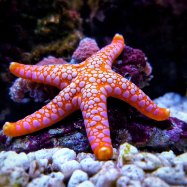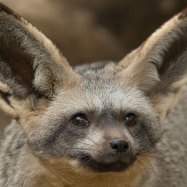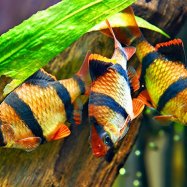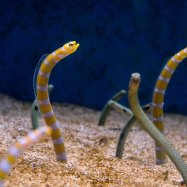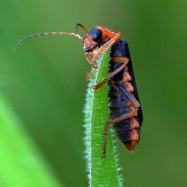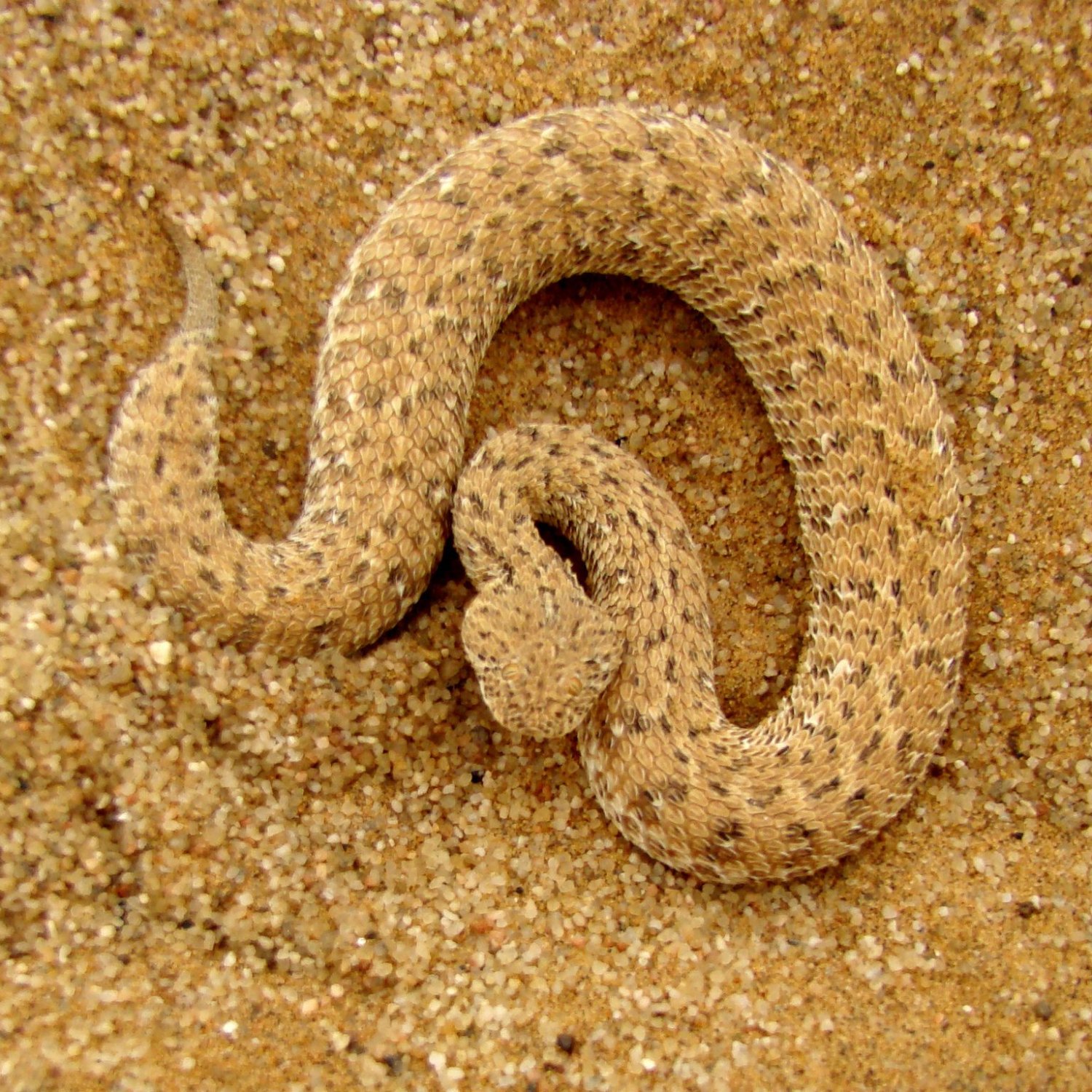
Peringueys Adder
Up to 20 centimeters
The Peringueys Adder, found in great numbers in the Central Namib Desert, is a small yet stout viper with a maximum length of 20 centimeters. This venomous snake, belonging to the Viperidae family, is known for its unique body shape and is a true wonder of nature. Keep an eye out for this mesmerizing creature on your next visit to the desert. #PeringueysAdder #Viperidae #NamibDesert
Animal Details Summary:
Common Name: Peringuey's Adder
Kingdom: Animalia
Habitat: Desert
The Secretive and Striking Peringuey's Adder: A Master of Survival in the Namib Desert
The Namib desert, one of the oldest and most arid deserts in the world, is home to some of the most unique and remarkable animals. Amidst this tough and unforgiving environment, lives a small yet powerful creature – the Peringuey's Adder (Bitis peringueyi).Named after the French naturalist Jacques André Havet Peringuey, who first discovered this elusive snake in 1901, the Peringuey's Adder is a fascinating and mysterious species that has captivated scientists and nature lovers alike.
In this article, we will delve into the world of this intriguing creature and learn about its characteristics, behavior, and survival in the harsh Namib desert Peringueys Adder.
A Member of the Viperidae Family
The Peringuey's Adder belongs to the family Viperidae, which includes some of the most venomous snakes in the world. This family is further divided into subfamilies, including Viperinae, which is where the Peringuey's Adder is classified.These snakes are found exclusively in southern Africa, and the Peringuey's Adder is one of the rarest and least studied species within this family. Its rarity and secretive nature have made it a challenge for researchers and wildlife enthusiasts to study and understand this species in its natural habitat.
The Perfectly Adapted Desert Dweller
The Namib desert is characterized by its harsh and unforgiving conditions – scorching hot temperatures, lack of water, and limited vegetation. But the Peringuey's Adder has adapted remarkably well to survive in this extreme environment.With a small and stout body, measuring up to 20 centimeters in length, the Peringuey's Adder is low to the ground, making it easier to hide from predators and prey. Its light brown to gray coloration, with dark brown or blackish bands, helps it blend in with the desert sand, making it almost invisible to the naked eye.
But what makes this snake a true master of survival is its ability to burrow into the sand Plott Hound Mix. With its shovel-like snout and strong, muscular body, the Peringuey's Adder can swiftly dig itself into the sand to escape extreme temperatures and predators.
A Carnivorous Diet
As with most snakes, the Peringuey's Adder is a carnivore, feeding on a variety of prey to sustain itself in the Namib desert. The primary diet of this snake consists of small lizards, such as skinks and geckos, which are abundant in the region. It may also feed on other small desert creatures, such as rodents and insects.To hunt its prey, the Peringuey's Adder uses its highly sensitive heat-sensing pits located between its eyes and nostrils. These pits allow the snake to detect the warmth of its prey, even in complete darkness. Once the prey is within striking distance, the Peringuey's Adder delivers a quick and lethal bite, injecting its venom into the prey's body.
A Mysterious and Shrouded Range
The geographical distribution of the Peringuey's Adder is limited to Namibia and Angola, making it a highly localized species. Within Namibia, it is found exclusively in the central Namib desert, near the coastal town of Swakopmund.Despite its small range, the Peringuey's Adder's exact distribution is still largely unknown. Due to its elusive nature, scientists have not been able to gather enough data on its population size and habitat preferences. However, it is believed that the snake's population is declining due to habitat destruction and human activities, such as off-road driving in the desert.
A Climate Change Sentinel
The Namib desert is a fragile ecosystem, and any changes in its climate can have a significant impact on the species living within it. As a resident of this desert, the Peringuey's Adder can serve as a sentinel species, indicating the health of the ecosystem.One study conducted by researchers from the University of Oxford found that the Peringuey's Adder is highly sensitive to changes in temperature and rainfall. With climate change bringing hotter and drier conditions to the Namib desert, this study suggests that the Peringuey's Adder may face difficulty in adapting to these changes, putting its survival at risk.
The Threat of Human Interaction
While climate change poses a threat to the Peringuey's Adder, human activities also play a significant role in the decline of this species. As mentioned earlier, off-road driving in the Namib desert can destroy the snake's habitat and disrupt its way of life.Moreover, the Peringuey's Adder is at risk of being accidentally killed by humans. Due to its small size and secretive nature, it can easily go unnoticed, and people may unintentionally step on it or drive over it. The use of pesticides and other chemicals in the desert also poses a threat to the snake's survival.
Conservation Efforts
Currently, the Peringuey's Adder is listed as ‘Vulnerable’ on the IUCN Red List, indicating its declining population and the need for conservation efforts. Namibia, as a country of origin, has laws in place to protect this species, making it illegal to harm, kill, or trade the Peringuey's Adder.However, more research and conservation efforts are needed to fully understand and protect this elusive creature. Scientists are working towards mapping its range, identifying habitat preferences, and studying its behavior in the wild. Such efforts are crucial in developing effective conservation strategies for the survival of the Peringuey's Adder.
A Symbol of Survival and Resilience
Despite its small size and lesser-known status, the Peringuey's Adder is a symbol of survival and resilience in the unforgiving environment of the Namib desert. Its ability to adapt and thrive in extreme conditions serves as an inspiration to us all.As we continue to learn more about this elusive and remarkable species, let us also make a conscious effort to conserve its habitat and protect it from human activities. The Namib desert may be a harsh environment, but the Peringuey’s Adder is a testament to the wonders of nature and the resilience of life.

Peringueys Adder
Animal Details Peringueys Adder - Scientific Name: Bitis peringueyi
- Category: Animals P
- Scientific Name: Bitis peringueyi
- Common Name: Peringuey's Adder
- Kingdom: Animalia
- Phylum: Chordata
- Class: Reptilia
- Order: Squamata
- Family: Viperidae
- Habitat: Desert
- Feeding Method: Carnivorous
- Geographical Distribution: Namibia, Angola
- Country of Origin: Namibia
- Location: Central Namib Desert
- Animal Coloration: Light brown to gray with dark brown or blackish bands
- Body Shape: Small and stout
- Length: Up to 20 centimeters
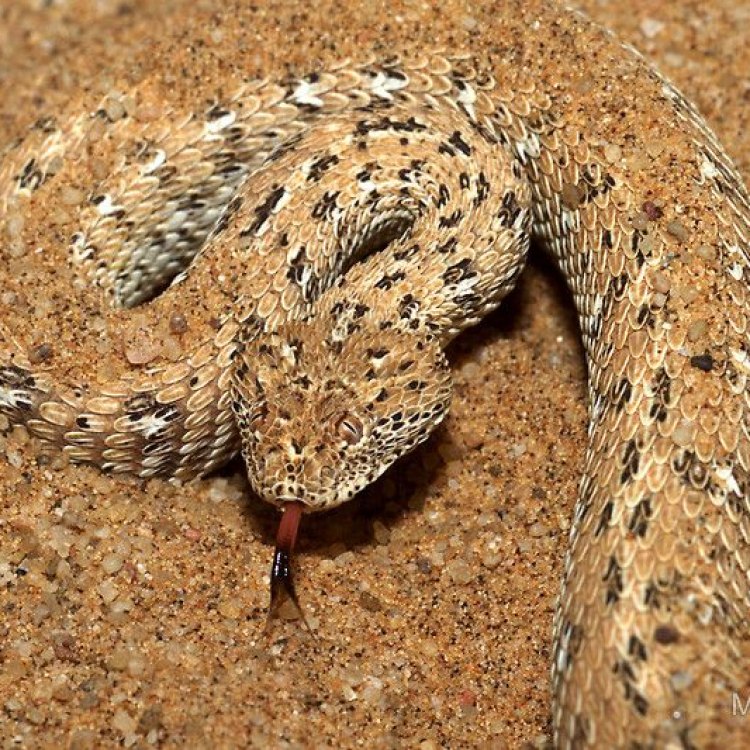
Peringuey's Adder
- Adult Size: Small
- Average Lifespan: Unknown
- Reproduction: Oviparous
- Reproductive Behavior: Mating occurs during the rainy season
- Sound or Call: Not known for vocalizations
- Migration Pattern: Non-migratory
- Social Groups: Solitary
- Behavior: Nocturnal and secretive
- Threats: Habitat destruction and fragmentation
- Conservation Status: Vulnerable
- Impact on Ecosystem: Key predator controlling rodent populations
- Human Use: None
- Distinctive Features: Short and stocky body, sharply-pointed snout
- Interesting Facts: Peringuey's adder is named after Gustav Alexander Peringuey, a South African entomologist and herpetologist
- Predator: Birds of prey, larger snakes
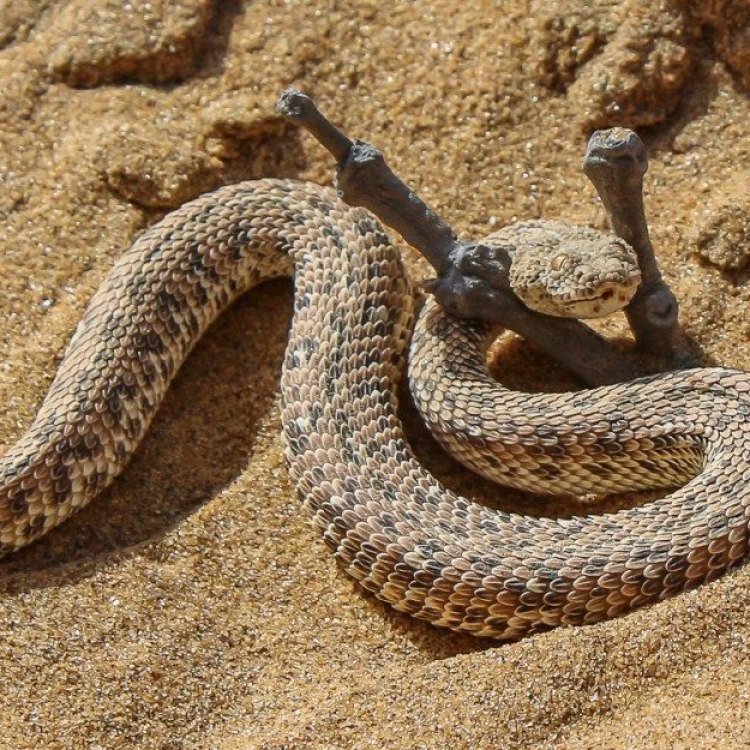
Bitis peringueyi
The Fascinating World of Peringuey's Adder: An Elusive and Important Predator
Peringuey's adder is a small yet captivating reptile that inhabits the arid regions of Namibia and South Africa. This elusive snake, also known as the Peringuey's sand adder, is a master of disguise and has unique features that make it stand out in the world of herpetology. Over the years, it has become a subject of interest for scientists and nature enthusiasts alike, yet it remains shrouded in mystery due to its solitary and nocturnal behavior. In this article, we will delve into the fascinating world of Peringuey's adder and uncover its distinctive features, behavior, and impact on its ecosystem PeaceOfAnimals.Com.The Habits of a Solitary and Secretive Predator
Peringuey's adder belongs to the family Viperidae and is a close relative of the puff adder. Unlike its notorious cousin, this snake is relatively small, with an adult size of only 20-40 cm. Its stocky body and short, sharply-pointed snout are two of its most distinctive features that help it blend into its sandy surroundings. The scales on its body are also unique, with a noticeable pattern of light and dark blotches that make it almost invisible when lying buried in the sand.
As the name suggests, Peringuey's adder is named after Gustav Alexander Peringuey, a renowned South African entomologist and herpetologist who first discovered and described this species in the late 19th century. Since then, it has captured the attention of many researchers, and yet, not much is known about its behavior and lifespan. Peringuey's adder is a secretive and solitary creature, making it challenging to study in its natural habitat.
The preferred habitat of this snake is the desert and semi-desert regions with loose sand and sparse vegetation. They can also be found in rocky areas and coastal dunes, but they are most commonly seen in the Namib Desert and the Western Cape of South Africa Plott Hounds. Due to their nocturnal nature, they spend most of their time hiding under the sand during the day, emerging at night to hunt for prey and engage in reproductive activities.
A Mysterious Mating Season
Reproduction is an essential aspect of any species' survival, and Peringuey's adder is no exception. However, not much is known about their reproductive behavior as they have yet to be observed in the wild. It is believed that mating occurs during the rainy season, which usually lasts from October to April in the regions where they are found. This timing could explain why not much is known about their reproduction, as it coincides with the harsh and unpredictable conditions of the desert.
One unique behavior observed in Peringuey's adder is their ability to inflate their bodies, making themselves look more prominent and more intimidating to potential predators or competitors. This behavior is especially prominent during the mating season when male adders compete for the attention of females. It is also believed that the males leave a trail of pheromones to attract females, but this is yet to be observed.
An Oviparous Species
Peringuey's adder is an oviparous species, meaning they lay eggs rather than giving birth to live young. In the case of this adder, the female can lay between 5-7 eggs at a time. The eggs are usually buried under the sand, where they are protected from predators and the harsh desert conditions. The incubation period is not precisely known, but it is estimated to be around 60 days. Once the eggs hatch, the young adders are left to fend for themselves, and little is known about their survival rate in the wild due to the challenges of monitoring them in their natural habitat.
Non-Migratory and Solitary Creatures
Peringuey's adder is a non-migratory species, meaning it does not move from one location to another. They are perfectly adapted to their desert environment, and it is unlikely for them to leave their habitat. As previously mentioned, they are solitary creatures, only coming together during the mating season. This behavior is common among vipers, as they are ambush predators that prefer to hunt independently.
A Key Predator in Controlling Rodent Populations
Despite their small size, Peringuey's adder plays a significant role in its ecosystem by controlling rodent populations. Rodents are a common prey for these adders, and their venom is highly effective in subduing their prey. By keeping rodent populations in check, Peringuey's adder helps maintain a balanced ecosystem and prevents overgrazing and destruction of vegetation.
However, despite their critical role in maintaining the ecosystem, Peringuey's adder is facing numerous threats, primarily due to human activities.
Conservation Status and Threats
Peringuey's adder is classified as vulnerable according to the International Union for Conservation of Nature (IUCN) Red List. Its population is declining due to habitat destruction and fragmentation. Human activities such as overgrazing, urban development, and mining have significantly reduced their suitable habitat, forcing them to compete for resources in smaller and isolated areas. This situation puts them at risk of inbreeding and reduces their chances of survival.
The Important Role of Community-Based Conservation
Efforts are being made to protect Peringuey's adder and its habitat. In what is known as community-based conservation, local communities are involved in the conservation of this species. By educating and involving the local people in monitoring and protecting the adders, it creates a sense of ownership and responsibility towards the species and its habitat. This approach has shown promising results in protecting Peringuey's adder and other endangered species in the region.
A Fascinating and Mysterious Reptile
Peringuey's adder is a unique and captivating reptile with distinct features and behaviors that set it apart from other snakes. Its role in controlling rodent populations makes it an essential predator in its ecosystem, and its elusive nature adds to its mystique. Although much is still unknown about its lifespan and behavior, efforts are being made to protect this vulnerable species and uncover its secrets. Let us hope that through conservation efforts, we can continue to discover and appreciate the beauty and importance of this fascinating reptile - the Peringuey's adder.

The Secretive and Striking Peringuey's Adder: A Master of Survival in the Namib Desert
Disclaimer: The content provided is for informational purposes only. We cannot guarantee the accuracy of the information on this page 100%. All information provided here may change without prior notice.


